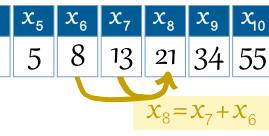Fibonacci Sequence
The Fibonacci Sequence is the series of numbers:
0, 1, 1, 2, 3, 5, 8, 13, 21, 34, ...
The next number is found by adding up the two numbers before it.- The 2 is found by adding the two numbers before it (1+1)
- The 3 is found by adding the two numbers before it (1+2),
- And the 5 is (2+3),
- and so on!
Example: the next number in the sequence above is 21+34 = 55
It is that simple!Here is a longer list:
0, 1, 1, 2, 3, 5, 8, 13, 21, 34, 55, 89, 144, 233, 377, 610, 987, 1597, 2584, 4181, 6765, 10946, 17711, 28657, 46368, 75025, 121393, 196418, 317811, ...
Can you figure out the next few numbers?
Makes A Spiral
When we make squares with those widths, we get a nice spiral:
Do you see how the squares fit neatly together?
For example 5 and 8 make 13, 8 and 13 make 21, and so on.
For example 5 and 8 make 13, 8 and 13 make 21, and so on.
The Rule
The Fibonacci Sequence can be written as a "Rule" (see Sequences and Series).First, the terms are numbered from 0 onwards like this:
| n = | 0 | 1 | 2 | 3 | 4 | 5 | 6 | 7 | 8 | 9 | 10 | 11 | 12 | 13 | 14 | ... |
| xn = | 0 | 1 | 1 | 2 | 3 | 5 | 8 | 13 | 21 | 34 | 55 | 89 | 144 | 233 | 377 | ... |
| Example: the 8th term is the 7th term plus the 6th term: x8 = x7 + x6 |  |
The Rule is xn = xn-1 + xn-2
where:- xn is term number "n"
- xn-1 is the previous term (n-1)
- xn-2 is the term before that (n-2)
Example: term 9 is calculated like this:
| x9 | = x9-1 + x9-2 |
| = x8 + x7 | |
| = 21 + 13 | |
| = 34 |
Golden Ratio

In fact, the bigger the pair of Fibonacci Numbers, the closer the approximation. Let us try a few:
A
|
B
|
B / A
| |
|---|---|---|---|
2
|
3
| 1.5 | |
3
|
5
| 1.666666666... | |
5
|
8
| 1.6 | |
8
|
13
| 1.625 | |
...
|
...
| ... | |
144
|
233
| 1.618055556... | |
233
|
377
| 1.618025751... | |
...
|
...
| ... |
A
|
B
|
B / A
| |
|---|---|---|---|
192
|
16
| 0.08333333... | |
16
|
208
| 13 | |
208
|
224
| 1.07692308... | |
224
|
432
| 1.92857143... | |
...
|
...
| ... | |
7408
|
11984
| 1.61771058... | |
11984
|
19392
| 1.61815754... | |
...
|
...
| ... |
Using The Golden Ratio to Calculate Fibonacci Numbers
And even more surprising is that we can calculate any Fibonacci Number using the Golden Ratio:Example:
Try it for yourself!
Some Interesting Things
Here is the Fibonacci sequence again:
There is an interesting pattern:
| n = | 0 | 1 | 2 | 3 | 4 | 5 | 6 | 7 | 8 | 9 | 10 | 11 | 12 | 13 | 14 | 15 | ... |
| xn = | 0 | 1 | 1 | 2 | 3 | 5 | 8 | 13 | 21 | 34 | 55 | 89 | 144 | 233 | 377 | 610 | ... |
- Look at the number x3 = 2. Every 3rd number is a multiple of 2 (2, 8, 34, 144, 610, ...)
- Look at the number x4 = 3. Every 4th number is a multiple of 3 (3, 21, 144, ...)
- Look at the number x5 = 5. Every 5th number is a multiple of 5 (5, 55, 610, ...)
1/89 = 0.011235955056179775...
Notice the first few digits (0,1,1,2,3,5) are the Fibonacci sequence?In a way they all are, except multiple digit numbers (13, 21, etc) overlap, like this:
| 0.0 |
| 0.01 |
| 0.001 |
| 0.0002 |
| 0.00003 |
| 0.000005 |
| 0.0000008 |
| 0.00000013 |
| 0.000000021 |
| ... etc ... |
| 0.011235955056179775... = 1/89 |
Terms Below Zero
The sequence works below zero also, like this:| n = | ... | -6 | -5 | -4 | -3 | -2 | -1 | 0 | 1 | 2 | 3 | 4 | 5 | 6 | ... |
| xn = | ... | -8 | 5 | -3 | 2 | -1 | 1 | 0 | 1 | 1 | 2 | 3 | 5 | 8 | ... |
(Prove to yourself that each number is found by adding up the two numbers before it!)
In fact the sequence below zero has the same numbers as the sequence above zero, except they follow a +-+- ... pattern. It can be written like this:
x−n = (−1)n+1 xn
Which says that term "-n" is equal to (−1)n+1 times term "n", and the value (−1)n+1 neatly makes the correct 1,-1,1,-1,... pattern.History
Fibonacci was not the first to know about the sequence, it was known in India hundreds of years before!
About Fibonacci The Man
His real name was Leonardo Pisano Bogollo, and he lived between 1170 and 1250 in Italy."Fibonacci" was his nickname, which roughly means "Son of Bonacci".
As well as being famous for the Fibonacci Sequence, he helped spread Hindu-Arabic Numerals (like our present numbers 0,1,2,3,4,5,6,7,8,9) through Europe in place of Roman Numerals (I, II, III, IV, V, etc). That has saved us all a lot of trouble! Thank you Leonardo.

No comments:
Post a Comment